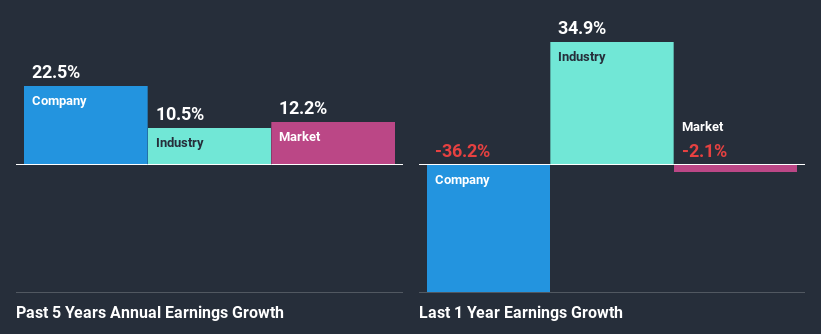Treasury Wine Estates Limited's (ASX:TWE) Stock On An Uptrend: Could Fundamentals Be Driving The Momentum?
Treasury Wine Estates' (ASX:TWE) stock is up by a considerable 17% over the past month. Given that stock prices are usually aligned with a company's financial performance in the long-term, we decided to study its financial indicators more closely to see if they had a hand to play in the recent price move. In this article, we decided to focus on Treasury Wine Estates' ROE.
ROE or return on equity is a useful tool to assess how effectively a company can generate returns on the investment it received from its shareholders. In short, ROE shows the profit each dollar generates with respect to its shareholder investments.
Check out our latest analysis for Treasury Wine Estates
How Is ROE Calculated?
The formula for ROE is:
Return on Equity = Net Profit (from continuing operations) ÷ Shareholders' Equity
So, based on the above formula, the ROE for Treasury Wine Estates is:
7.2% = AU$261m ÷ AU$3.6b (Based on the trailing twelve months to June 2020).
The 'return' is the amount earned after tax over the last twelve months. Another way to think of that is that for every A$1 worth of equity, the company was able to earn A$0.07 in profit.
What Is The Relationship Between ROE And Earnings Growth?
So far, we've learned that ROE is a measure of a company's profitability. Depending on how much of these profits the company reinvests or "retains", and how effectively it does so, we are then able to assess a company’s earnings growth potential. Generally speaking, other things being equal, firms with a high return on equity and profit retention, have a higher growth rate than firms that don’t share these attributes.
Treasury Wine Estates' Earnings Growth And 7.2% ROE
At first glance, Treasury Wine Estates' ROE doesn't look very promising. Yet, a closer study shows that the company's ROE is similar to the industry average of 6.4%. Moreover, we are quite pleased to see that Treasury Wine Estates' net income grew significantly at a rate of 22% over the last five years. Given the slightly low ROE, it is likely that there could be some other aspects that are driving this growth. For instance, the company has a low payout ratio or is being managed efficiently.
As a next step, we compared Treasury Wine Estates' net income growth with the industry and found that the company has a similar growth figure when compared with the industry average growth rate of 22% in the same period.
The basis for attaching value to a company is, to a great extent, tied to its earnings growth. The investor should try to establish if the expected growth or decline in earnings, whichever the case may be, is priced in. This then helps them determine if the stock is placed for a bright or bleak future. If you're wondering about Treasury Wine Estates''s valuation, check out this gauge of its price-to-earnings ratio, as compared to its industry.
Is Treasury Wine Estates Using Its Retained Earnings Effectively?
Treasury Wine Estates has a significant three-year median payout ratio of 67%, meaning the company only retains 33% of its income. This implies that the company has been able to achieve high earnings growth despite returning most of its profits to shareholders.
Moreover, Treasury Wine Estates is determined to keep sharing its profits with shareholders which we infer from its long history of nine years of paying a dividend. Based on the latest analysts' estimates, we found that the company's future payout ratio over the next three years is expected to hold steady at 64%. Regardless, the future ROE for Treasury Wine Estates is predicted to rise to 12% despite there being not much change expected in its payout ratio.
Summary
In total, it does look like Treasury Wine Estates has some positive aspects to its business. Namely, its high earnings growth. We do however feel that the earnings growth number could have been even higher, had the company been reinvesting more of its earnings and paid out less dividends. That being so, a study of the latest analyst forecasts show that the company is expected to see a slowdown in its future earnings growth. To know more about the company's future earnings growth forecasts take a look at this free report on analyst forecasts for the company to find out more.
This article by Simply Wall St is general in nature. It does not constitute a recommendation to buy or sell any stock, and does not take account of your objectives, or your financial situation. We aim to bring you long-term focused analysis driven by fundamental data. Note that our analysis may not factor in the latest price-sensitive company announcements or qualitative material. Simply Wall St has no position in any stocks mentioned.
Have feedback on this article? Concerned about the content? Get in touch with us directly. Alternatively, email editorial-team@simplywallst.com.

 Yahoo Finance
Yahoo Finance 
